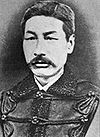
Takeda Ayasaburo
Encyclopedia

, was a Japanese
Japanese people
The are an ethnic group originating in the Japanese archipelago and are the predominant ethnic group of Japan. Worldwide, approximately 130 million people are of Japanese descent; of these, approximately 127 million are residents of Japan. People of Japanese ancestry who live in other countries...
Rangaku
Rangaku
Rangaku is a body of knowledge developed by Japan through its contacts with the Dutch enclave of Dejima, which allowed Japan to keep abreast of Western technology and medicine in the period when the country was closed to foreigners, 1641–1853, because of the Tokugawa shogunate’s policy of national...
scholar, and the architect of the fortress of Goryōkaku
Goryokaku
is a star fort in the city of Hakodate in southern Hokkaidō, Japan. It was the main fortress of the short-lived Republic of Ezo.- History :Built by the Tokugawa shogunate in 1857-1866, it was located in the center of the port of Hakodate, on the island of Hokkaidō...
in Hokkaidō
Hokkaido
, formerly known as Ezo, Yezo, Yeso, or Yesso, is Japan's second largest island; it is also the largest and northernmost of Japan's 47 prefectural-level subdivisions. The Tsugaru Strait separates Hokkaido from Honshu, although the two islands are connected by the underwater railway Seikan Tunnel...
.
Takeda was born in the Ōzu Domain
Ozu Domain
was a Japanese han or fief centered on Ōzu in Iyo Province . It was governed from Ōzu Castle.Ōzu Domain was abolished, along with all the other han, in 1871.-House of Katō:#Katō Sadayasu #Katō Yasuoki...
(modern-day Ōzu, Ehime
Ozu, Ehime
is a city located in Ehime, Japan.On January 11, 2005 Ōzu absorbed the towns of Hijikawa and Nagahama, and the village of Kawabe, all from Kita District, to form the new and expanded city of Ōzu....
) in 1827. He studied medicine, Western sciences (rangaku), navigation, military architecture. He was a student of Ogata Kōan and Sakuma Shōzan
Sakuma Shozan
sometimes called Sakuma Zōzan, was a Japanese politician and scholar of the Edo era. He was the son of a samurai, and a native of Shinshu in today's Nagano-ken.From the age of 23, he went to Edo and for 10 years studied Chinese sciences ....
. In 1854 he was ordered to the island of Hokkaidō
Hokkaido
, formerly known as Ezo, Yezo, Yeso, or Yesso, is Japan's second largest island; it is also the largest and northernmost of Japan's 47 prefectural-level subdivisions. The Tsugaru Strait separates Hokkaido from Honshu, although the two islands are connected by the underwater railway Seikan Tunnel...
to reinforce the military infrastructure.
He built the fortresses of Goryōkaku
Goryokaku
is a star fort in the city of Hakodate in southern Hokkaidō, Japan. It was the main fortress of the short-lived Republic of Ezo.- History :Built by the Tokugawa shogunate in 1857-1866, it was located in the center of the port of Hakodate, on the island of Hokkaidō...
and Benten Daiba
Benten Daiba
was a key fortress of the Republic of Ezo in 1868-1869. It was located at the entrance of the bay of Hakodate, in the northern island of Hokkaidō, Japan....
between 1854 and 1866, using Dutch books on military architecture describing the fortification of Vauban
Vauban
Sébastien Le Prestre, Seigneur de Vauban and later Marquis de Vauban , commonly referred to as Vauban, was a Marshal of France and the foremost military engineer of his age, famed for his skill in both designing fortifications and breaking through them...
, and also established a school. He also practiced sailing with the Hakodate Maru, one of Japan's first Western-style sailing ship, together with his students. He sailed to Russia with the ship, and engaged in some exchanges.

